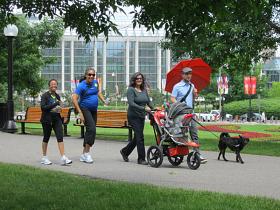How walkable is Ottawa?
Lana Stewart from Walk Ottawa is trying to raise the profile of pedestrian issues in the city and get others involved with improving city streets for pedestrians. Lana says their site, ottawawalkingproblems.ca, has had almost 120 problems reported already. Problems include bad sidewalks, areas without crosswalks, accessibility issues and poorly timed pedestrian signals. The first FAQ on Ottawa Walking Problems is “Why bother?” which illustrates one of the main problems when trying to deal with pedestrian issues: often even avid walkers don’t strive to make their streets better. But, as the site outlines, the City “spent a whole lot of money developing a Pedestrian Plan for this city, but have no money to implement it unless it is a sidewalk attached to a major roadway renewal project.” In order to get the necessary work done on pedestrian issues, Stewart says the first step is letting the City know that people care about these issues. Stewart wants problems reported so she can compile them and present them to the City, but this is a lengthy process. Stewart also suggests that people call 311 or their councillors to report their concerns directly. Collisions involving pedestrians have and will occur in Ottawa, but that doesn’t mean they should be viewed as inevitable. When a pedestrian is hit by a car, it shows where the relationship between drivers and pedestrians has failed. Of the many road users, pedestrians are the most vulnerable, something the City of Ottawa recognizes in its master plan. But pedestrians’ issues around vulnerability are rarely addressed. Road and sidewalk maintenance are methods for addressing pedestrian issues, but these projects can overlook certain details such as accident prevention and pedestrian vulnerability. Ottawa is a city that needs to consider the pedestrians on its streets. Based on the 2001 Census data, Ottawa leads in people who are walking to work at 7.5%, “leading all other big cities in Canada. Vancouver comes next with 6.5%. Montreal and Calgary are tied for third with 5.9%, Edmonton takes fourth place with 4.7% and Toronto comes last with 4.6%.” But pedestrian issues arise all over the city and some residents and councillors want to take steps towards bettering Ottawa’s walkability. Stewart hopes that councillors start to take these concerns into consideration, as it’s an “easy win” for councillors to fix what are often small and relatively inexpensive problems. But just as every ward has their pedestrian issues, the opinions on what is a priority differs throughout the city. Barrhaven is skipping sidewalks from new developments in order to provide homeowners with more yard space, putting those who choose to walk on the road. This issue is clearly important to the homeowners who want to optimize their lawn space, but it doesn’t encourage creating walkable communities. Ottawa’s inner wards have different concerns. Kitchesippi councillor Katherine Hobbs supports lowering the residential speed limit to 40 km/h. This is a proposal that pedestrian advocates would support, but does not have universal appeal. Stewart says most of the problems reported on Ottawa Walking problems occur in Centretown. Councillor Diane Holmes is already outspoken on pedestrian issues, holding her own “sidewalk summit” to raise awareness about some of the important issues of active transport in the city. Holmes says one of the biggest issues is that there is no city staff member working solely on pedestrian issues. Holmes says this is indicative of the fact that the “bureaucracy doesn’t consider pedestrians to be important.” Holmes says that the Official Plan for the City of Ottawa states that pedestrians come first but “these wonderful statements are never actioned.” But if the desire to make Ottawa better for pedestrians has been outlined by the City, it must be reinforced by its concerned citizens. There are many ways for people to express their individual concerns about walkability and pedestrian issues. Part of the issue is increasing the awareness of how pedestrian issues affect people in Ottawa. In honor of the approaching Jane’s Walk this weekend, check out how walkable your neighbourhood is at Walk Score, a site that breaks it down by number. Though the site itself acknowledges certain aspects of walkability its algorithm can’t account for, it’s an interesting look at how cities make themselves walkable and how walkability is discouraged by design. So Ottawa, how does your neighbourhood rate on walkability?
Internet site reference: http://apt613.ca/walkability-post-unfinished
Comments
There are 0 comments on this post













